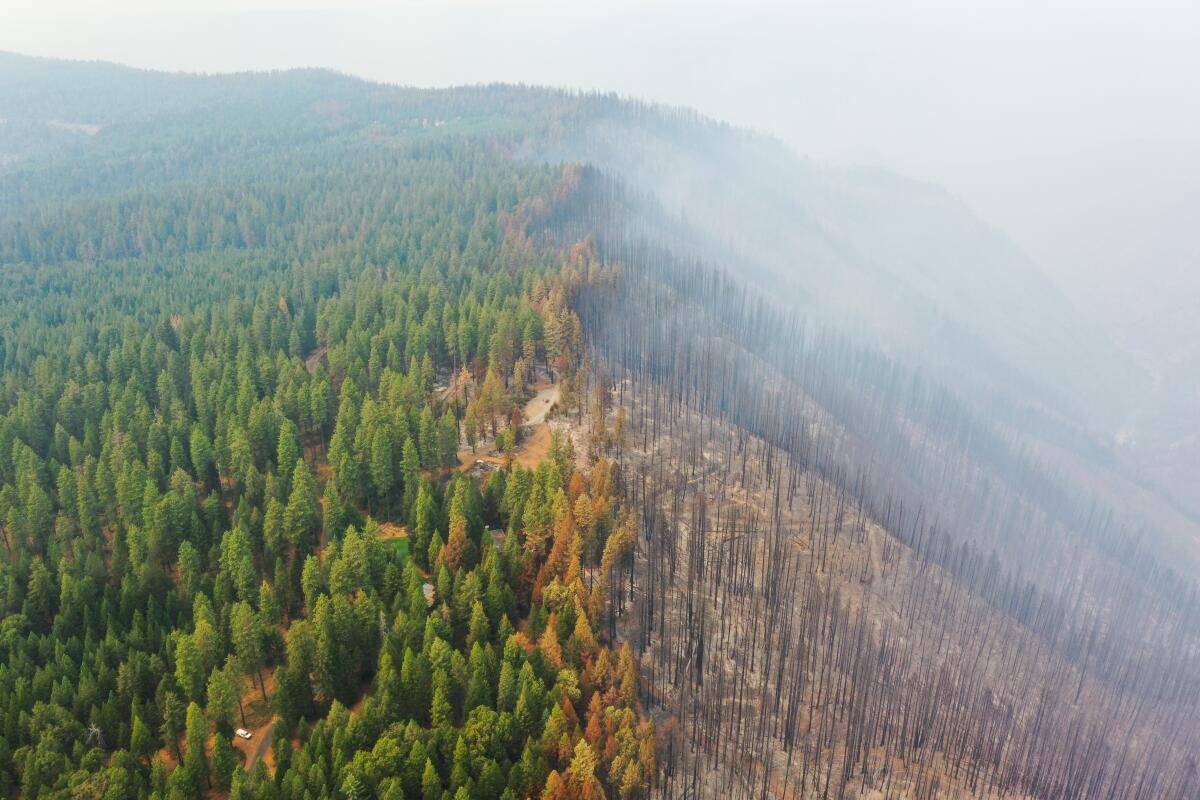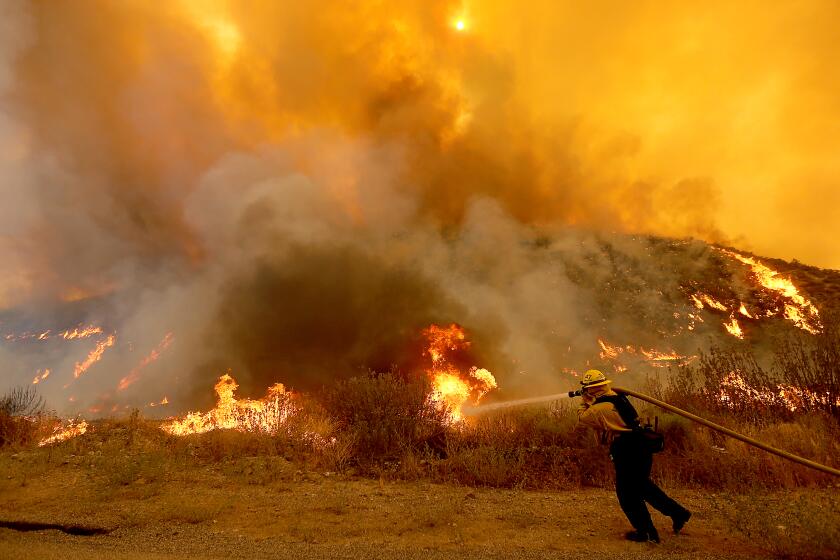Mosquito fire grows past 50,000 acres in ‘historically dry’ brush as another blaze ignites west of Tahoe

- Share via
Firefighters continued making progress on a 50,000-acre blaze in Placer and El Dorado counties Tuesday, but shifting winds and “critically dry fuels” led to increased activity in the burn area, fire officials said, as a new wildfire broke out to the north.
The Mosquito fire was 25% contained Tuesday night, growing by 569 acres compared with that morning — from 49,761 acres to 50,330 acres, according to the California Department of Forestry and Fire Protection.
Jonathan Pangburn, a fire behavior analyst with the agency, said the area’s extremely dry brush and trees — what he called “record-breaking fuels” and “historically dry fuels” — would easily burn as a shift in winds pickedup over the wildfire.
By Tuesday evening, fire officials noted that slightly stronger southeast winds broke up a smoke inversion, when warm air traps smoke and cooler air below, which cleared by midday and led to significantly increased fire activity as levels of available oxygen rose in the area.
A spot fire jumped the Middle Fork of the American River on Tuesday afternoon in the Pond Creek drainage on the west corner of the fire’s perimeter, according to Cal Fire.
The spot fire, spurred by dry vegetation, steep terrain and increased ventilation, grew rapidly toward the community of Foresthill.
“Firefighters and resources from around the fire have been diverted to assist with holding this corner of the fire at the contingency lines that have been put in place by crews over the past week below the community,” Cal Fire officials said.
Firefighting aircraft aided ground crews in defending structures and working to hold the spot fire.
The fire was continuing to advance to the east in heavily forested areas with extremely dry fuels, fire officials said.
Similar weather conditions were forecast for the next several days.
The Mosquito fire began Sept. 6, in the throes of the state’s worst September heat wave.
Meanwhile, a new fire broke out Tuesday afternoon in the community of Dutch Flat, to the north of the Mosquito burn area.
The Dutch fire was reported shortly before 1 p.m. near Interstate 80 and Ridge Road, according to Cal Fire. It was last reported at 30 acres and 30% containment Tuesday evening.
The California Department of Transportation closed westbound I-80 at its junction with Highway 20 at 2 p.m. As of Tuesday evening, Caltrans officials had not announced when the interstate would reopen.
Before clearing on Tuesday afternoon, smoke from the Mosquito fire damaged air quality across the region, as far as 100 miles to the north and northwest of the blaze, into communities in the northern Sierra foothills and western Nevada. The U.S. Interagency Wildland Fire Air Quality Response Program warned of “particularly high smoke levels” from the Mosquito fire, especially for Truckee, Reno and Carson City.
Some experts say the restrictions create more barriers to doing controlled burns precisely when the need for them is most acute.
Conditions on Monday were “particularly bad,” said Edan Lindaman, a senior meteorologist with the National Weather Service in Reno.
Much of the Reno area was affected by unhealthy air quality Tuesday morning, according to the U.S. Air Quality Index, but around Carson City and South Lake Tahoe, the air had significantly improved to “good” or “moderate” levels.
Much of the areas west and northwest of the Mosquito fire — from Foresthill and Colfax and into the Grass Valley — remained in “unhealthy” or “very unhealthy” levels for air quality Tuesday morning.
Meteorologist Ryan Walbrun, with the National Weather Service, called Tuesday a “critical day” for the blaze, given the change in weather, from tropical moisture in the air to some southwest winds.
“Much stronger winds aloft, not necessarily down at the surface,” Walbrun said. “What that’s going to do is allow the fire to ventilate.”
Thousands have been forced to evacuate from those areas and others surrounding the blaze, with 46 structures already destroyed in the fire and almost 6,000 more threatened, according to Cal Fire.
Guests who book vacation rentals through Airbnb often have no idea that they’re booking in a high-risk fire area. And the company provides no warning or escape plan if disaster strikes.
Firefighters have been able to steadily increase containment over the last few days, with almost 2,400 crew members assigned to the wildfire.
“You could characterize the fire activity as minimal [last night],” said Don Fregulia, a U.S. Forest Service official who led the fire response’s night operation. “The work last night, though, was intense, and there was a ton of it going on.”
More to Read
Sign up for Essential California
The most important California stories and recommendations in your inbox every morning.
You may occasionally receive promotional content from the Los Angeles Times.















